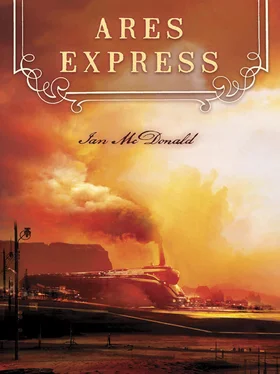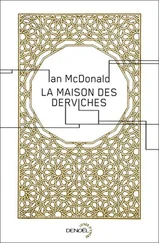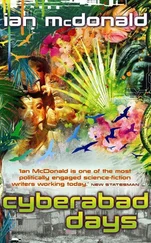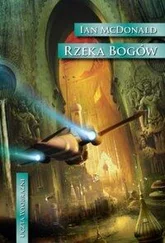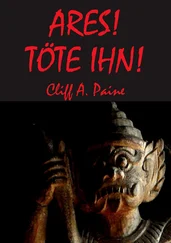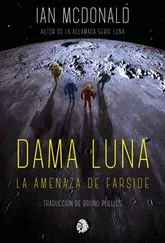“Eh!”
“Safe enough.”
“Then let’s get vertical!”
Before question or protest, more hands seized Pharaoh. Motors churned a second, then captors, captive and all were whisked straight up into the darkness.
“The Vertical Boys, that’s what they call themselves,” Pharaoh said. “ Los Verticales .”
“There’s lots like that, up here,” Sweetness said. “I seen them up on the glass; kids’ nations, all that stuff. Runaways, thinking like they’re kings. They aren’t as flash as they think they are.”
Again, the thought of the fall of the Seven-Ups Girl Nation. Thought, and immediately unthought. Would it have been worth being a chandelier not to feel guilty about surviving? Stupid. Almost as stupid as diving over a thousandth-level balcony because all you could do was trust that you were still a story.
“They just want a place of their own, that’s all,” Pharaoh said. “Bastards won’t let you live, up here. There’s enough room for a million Vertical Boys, but even if they don’t use it they’re not going to let you have it. Their umpteen-times grandfather cleaned glass for this, you know. They earned it; and what have we done to deserve it? You got to fight. You got to squat on it and say hey, it means so much to you, you take it off me. That’s all these people understand.”
Sweetness rolled on to her side, tucked the blankets around her in a way she hoped was kitteny and cute. An idea was forming.
“So how many of them are there?”
“Two, three hundred.”
It must be cosy and reeky in those little plastic bladders. Sweetness’s estimate, from her queasy survey of the Vertical squatter-town, had been considerably lower. Two hundred was good. Three hundred, excellent.
“With beanie guns,” she said. “You going to stun them to death?”
“Hey, those beanie guns saved my ass, so I could save your ass from those furniture folk.”
“Okay okay, so that’s us even on the I-owe-you-my-life stakes. Now, correct me if I’m wrong, but sometimes an outside viewpoint can give a whole new perspective on things—but you’ve got like one razor between the lot of youse and these window-cleaning aristos, one click of the fingers and there are two divisions of mercenaries sticking their laser-sights up your hole. Right now, you’re just a mild irritation. Moment you ever start to look like a threat, you’re all either down the chute or you’re in the black suit with your balls sticking out like two eggs in a handkerchief. Now, if you had weapons, and I mean real weapons, you could take these people by surprise. Blow them clean out in one go.”
She gave Pharaoh a teasing glance, loosened her shirt under the blankets and let her mantle slip a little. How long since you glimpsed the sweet and unaffordable flesh of a fine woman, railrat?
“What do you know about weapons?”
“I know there’s Gatlings and lasers and hunter-droids, man, not a day’s sail from here.”
“Tell me more.”
“Oh, I will, but first, I have to tell you a little story. It’s about St. Catherine, and mirrors, and a flying cathedral…”
27

Foolish folk will tell you that trains are intrinsically happy things. They are bright, speedwell creatures of pomp and steam, like well-fed cheerful uncles. They take people on journeys and life, such folk believe, is journey. A train is a thousand stories, each carriage, each compartment, each seat row crammed more full with motive and emotion and drama than any book. If, as the Masters of Narratology maintain, all story is journey; the converse is also true; there is no journey that does not have a story in its ticket price. Trains bringing lovers together. Trains carrying hopeful families to new lives. Trains taking bright young people to brilliant success in the cities. Trains taking the old to meet the new generations of their people. Engines of change, garlanded with flowers. Happy things.
People wiser in the ways of trains know that for every happy train there is a train of sorrow. For every holiday special there is a packed commuter, for every young hopeful there is a freeloader clinging to the bogies and for every reunion there is a final parting. Trains of farewell. Trains of fatalism, and passivity. Trains of exile. Trains of extermination. Death trains, on which we all must ride, carried at ever higher speeds by forces over which we have no control, directed by rails we did not set, into the tunnel that never ends. And the communication cord is snapped.
The wisest in the ways of trains count a third category; trains of no emotional content. Freight trains. Bulk carriers. Vast, slow-moving ore trains, big enough to be visible from orbit. Trains made up of grain silos, cement wagons, chemical tankers, lumber racks, agricultural machinery flatbeds, grazer cars, hydrocarbon processors, container pallets, paper mills; trains of oils and minerals and big red rocks. Trains of silk and straw and exotic fruit. Trains of glass and tin; tea and spices. Trains with no cargo of human feeling. These, such people say, are the truest trains, for they expose the soft anthropomorphism of those who must project feelings all around them. A train is nothing but a big chunk of inter-related metal parts wrapped around a hydrogen fusion/superheat steam boiler combo. Classically structured, a piece of pure operating logic. Any emotional freight is the property of its passengers and crew.
As example, they will say, here is a train. It’s coming on down the line. Let’s start at the front and see if there is anything about it that could teach us about happiness and sorrow.
We start with a pair of nipples, silver, quite erect. From them we move back over the areolas, the proud, firm and outsized breasts to the curved-back torso of a woman, chin proudly aloft, hair streaming out behind her. We note that the silver woman has wings for arms, and that they are folded back around the boiler cap. Back along the swelling curve of the boiler to the cyclops eye of the headlamp, over the tiers of outlook galleries and catwalks to the gold-plated anti-glare glazing of the driving bridge where the Engineer stands, hand on the thrust bar, eye on the quartersphere ball, thence by the black and silver livery of Bethlehem Ares Railroads to the streamlined wedge of the main stack. A moment’s pause to peep down the steam flues in the raving heart of the machine. On, over the fluid humps of the reheat coil and the Deep-Fusion homesteads, to the ornately filigreed hydro-helium tanks and the water tender with their turrets and watch-houses, the last outpost of the Engineer Domiety before we pass from driver to driven: the train proper. We enter here the territory of the Stuards; from single sleek, slim-line executive express cars to ten kilometres of ore trucks, from pilgrims clacking their beads to polymer processors, all are their responsibility, all are tended with equal attention. Today this service is hauling an organic chemical processor: the first fifteen cars we fly over are stacked with logs from the great polar taigas of Treeves and Raskolnikov. A beltway feeds them one by one to the chipping plant in car sixteen and from there into the bacterial fermentories, reactor plants and cracking towers of the middle section of the train. We glide over cylinders and chimneys and cooling ducts, rivers of pipework and power conduits, separator grids, pumps, distillation columns, wash-backs and vents jetting waste gasses. Brute industry. No emotion here. Now we follow the loops of colour-coded piping to the storage section of the factory-train where each separated fraction is channelled into the appropriate receiving tank. Some bear large and flagrant warning symbols, others are wreathed in mist from cooling tubes, others still carry prominent pressure release valves and little vent-flaps that flutter and chirp as the whole ensemble makes its ponderous way across the unhedged grainlands of central Axidy.
Читать дальше
